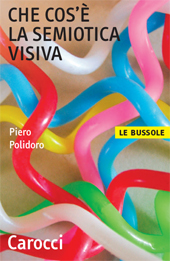| HOME MAIL |
| SEMINARIO CURRICULUM CORSO DI TERAMO |
CHE COS'E' LA SEMIOTICA VISIVA (WHAT IS VISUAL SEMIOTICS)
di Piero Polidoro, Carocci, Roma 2008, 128 pages, 10 euros.
Language: Italian
Visual semiotics is part of semiotics, a discipline studying languages and texts both from a theoretical point of view and from an applicative one. The task of visual semiotics is to analyse images (paintings, drawings, photos...).
Visual semiotics has many questions to answer. For example, it studies the recognition process: we have lines and colours on a bi-dimensional surface and we see representations of 3D objects. But this process is not completely “natural” as we could think: it is also based on cultural laws, that we have to study (iconism problem).
Visual semiotics is interested by other problems too. Which conventional rules help us recognizing characters and actions? How can images narrate stories or represent the time passing? How can visual texts produce effects of involvement or distance of the observer using the position of the characters or their gaze (visual enunciation problem)?
An important part of Visual semiotics is Plastic semiotics. It studies the meaning of lines, colours and visual configuration in general, independently from what they represent. These can in fact create effects of visual balance, dynamism, tension. Visual configurations can also have more complex and articulated meanings and they can be used to make visible on the surface of the text its deep meaning.
This book is an introduction to Visual semiotics (its theories and its main tools). It shows how to analyse images using Semiotics and other disciplines, as Iconography and Psychology of perception.
This book has been written not only for an academic public, but also for those who work or simply are keen on visual communication. When a theoretical concept is used, it is always explained. So, no preceding semiotic knowledge is required.
The author
Piero Polidoro is PhD in Semiotics, University of Bologna, and he studied with professor Umberto Eco. Polidoro taught Semiotics in Rome (University “La Sapienza”) and in Teramo. His main interest are visual semiotics and visual perception.
buy this book on Carocci's website
(if you don't see the page about this book, close the browser window and please click again on this link)
COMPLETE INDEX
Introduction
Chapter 1. Iconic signs and the representation of the world
1.1 Figurative semiotics
1.1.1. The recognition and the debate on iconic signs
1.1.2. Cognitive types
1.1.3. Ipo-icons: between natural and conventionality
1.1.4. Greimas and “natural world”
1.2. The representation of time
1.2.1. Movements and actions
1.2.2. Iconic narration
Summary
Chapter 2. How to give a meaning to images
2.1. Iconography, iconology and semiotics
2.1.1. Iconography
2.1.2. Iconology
2.1.3. The dialogue with semiotics
2.2. Connotation
2.2.1. How verbal texts interact with images
2.3. Visual texts and rethorical mechanisms
2.3.1. Metonymy
2.3.2. Metaphor
Summary
Chapter 3. Narrative structures in images
3.1. The narrative scheme
3.1.1. Visual examples
3.2. The “generative path” of narrativiy
3.2.1. Deep semio-narrative structures
3.2.2. The semiotic square
3.2.3. Superficial semio-narrative structures
3.2.4. Discoursive structures
3.3. Advertising philosophies and images
Summary
Chapter 4. Visual enunciation
4.1. Enunciation theory
4.1.1. Débrayage
4.1.2. Débrayage in visual texts
4.1.3. Gaze and portraits
4.2. Point of view
4.2.1. The position of the spectator
4.2.2. Observer
4.2.3. Commentators
4.3. The enunciation discourse
4.3.1. “Transparency” and “opacity” of images
4.3.2. Frames, windows, niches, doors
4.3.3. The representation of the enunciator
4.3.4. An example: Signorelli’s frescoes in Orvieto
Summary
Chapter 5. Psychology of perception and basic effects of plastic language
5.1. What is plastic language
5.1.1. From Hogarth to Greimas
5.1.2. Two ways of studying plastic language
5.2. Psychology of perception and Gestalt theory
5.2.1. Figural unification laws
5.2.2. Figure/background
5.2.3. Applying Gestalt laws
5.2.4. The “good form”
5.3. Visual balance
5.3.1. Vectors
5.3.2. Visual balance analysis
5.4. Reading direction in images
5.4.1. Explanation
5.4.2. Japanese images
Summary
Chapter 6. Plastic language and structuralist analysis
6.1. Plastic categories
6.1.1. Eidetic categories
6.1.2. Chromatic categories
6.1.3. Topologic categories
6.1.4. Other plastic categories
6.2. How to analyse plastic meaning
6.2.1. Plastic symbolism
6.2.2. Description and first meanings
6.2.3. Comparation
6.3. Semi-symbolic systems
6.3.1. Types of semi-symbolic systems
6.3.2. Analysis
6.3.3. Theoretical aspects
6.3.4 Semi-symbolic systems and myth structures in visual texts
Summary
Bibliography

| English version of this page |